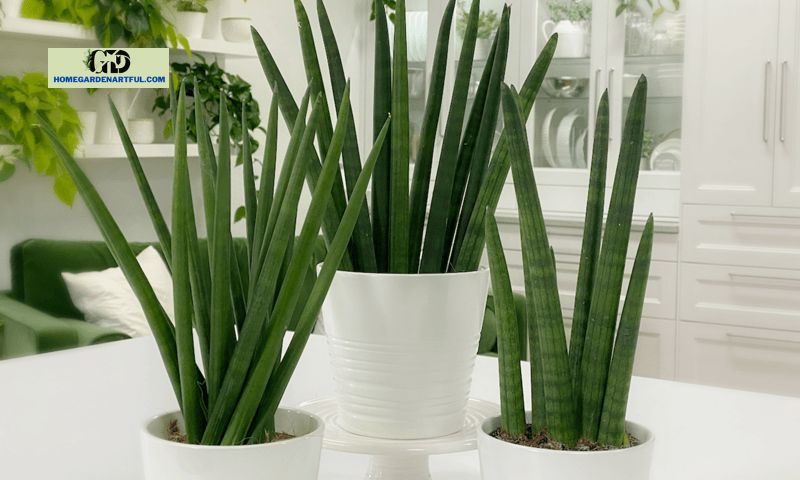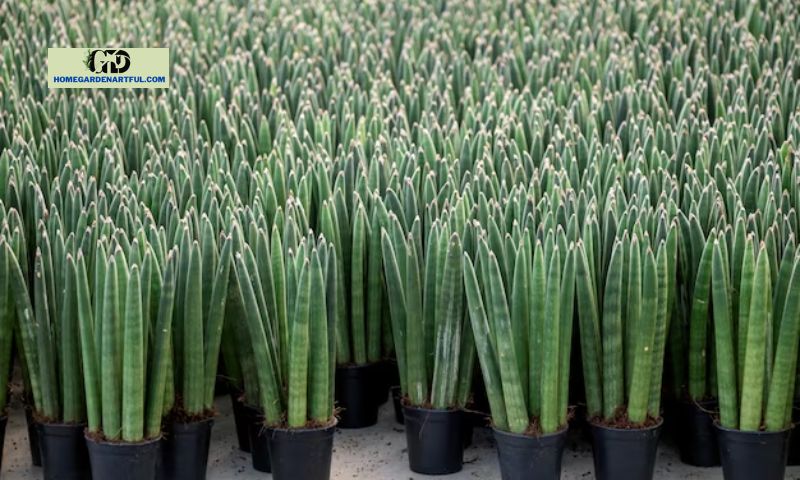Discover the secrets of propagating the cylindrical snake plant with our comprehensive guide. Learn various methods and essential care tips for successful propagation.
Unveiling the Uniqueness of Cylindrical Snake Plants
Are you a plant enthusiast searching for the perfect addition to your indoor garden? Look no further – the cylindrical snake plant is here to captivate both your heart and space! In this article, homegardenartful.com will introduce you to the intriguing world of cylindrical snake plants and unravel the distinctive features that make them an exceptional choice for any plant lover.
A Brief Overview of Snake Plants
Before delving into the realm of cylindrical snake plants, let’s briefly explore the wider family of snake plants. Also known as Sansevieria, snake plants are renowned for their resilience and ability to thrive in various environments. These plants boast long, sword-like leaves that elegantly sway, creating a mesmerizing ambiance in any room.
Introduction to Cylindrical Snake Plants and Their Unique Characteristics
Now, let’s turn our attention to the star of the show – the cylindrical snake plant. As the name suggests, this variety showcases cylindrical-shaped leaves, setting it apart from its counterparts. With a sleek, tubular structure, cylindrical snake plants add a touch of sophistication to your indoor oasis. Their distinct appearance, resembling a cluster of green pipes, makes them a true conversation starter and a visually striking choice for any plant collection.
But there’s more to cylindrical snake plants than their captivating form. These plants are not just a treat for the eyes; they also offer numerous benefits that make them an ideal choice for both novice and seasoned plant enthusiasts. From their air-purifying properties to their low-maintenance nature, cylindrical snake plants effortlessly combine beauty and practicality.
In the upcoming sections, we will delve deeper into the characteristics, care tips, propagation methods, common issues, and more, to equip you with a comprehensive understanding of how to cultivate and nurture your very own cylindrical snake plant. So, let’s embark on this green journey together and unlock the secrets of this extraordinary plant species.
Stay tuned for Section II, where we will explore the mesmerizing characteristics of cylindrical snake plants and unveil their hidden allure.
Characteristics of Cylindrical Snake Plants

A. Description of the Plant’s Appearance and Structure
When it comes to aesthetics, cylindrical snake plants are unparalleled. Their unique appearance sets them apart from other members of the snake plant family. Picture slender, cylindrical leaves that rise gracefully from the soil, reaching toward the sky. These leaves, often clustered together in groups, create a stunning architectural display in your indoor oasis. Their vibrant green hue adds a touch of freshness to any space, breathing life into even the dullest corners of your home.
The structure of cylindrical snake plants is truly a marvel. Unlike the flat, sword-like leaves of their relatives, the cylindrical variety showcases sleek, tubular foliage. This distinct shape provides an intriguing contrast to other plants in your collection, making them a standout feature. Whether displayed as a centerpiece or nestled amongst other leafy companions, cylindrical snake plants infuse elegance into any arrangement.
B. Discussing the Growth Patterns of Cylindrical Snake Plants
Understanding the growth patterns of your beloved plant is essential for its proper care and maintenance. Cylindrical snake plants exhibit a slow but steady growth rate, ensuring they remain compact and manageable. As they mature, new leaves emerge from the center, gradually unfurling and adding to the overall beauty of the plant. With proper care and adequate conditions, these magnificent plants can reach heights of up to 2 feet, creating a striking vertical element in your indoor garden.
C. Highlighting the Benefits of Having Cylindrical Snake Plants as Indoor Décor
Apart from their aesthetic allure, cylindrical snake plants offer a range of benefits that make them an ideal choice for indoor décor. These plants are renowned for their air-purifying properties, effectively removing toxins such as formaldehyde and benzene from the surrounding environment. By incorporating cylindrical snake plants into your living spaces, you can create a healthier and more harmonious atmosphere.
Moreover, these plants are low-maintenance and resilient, making them perfect for busy individuals or those new to plant care. Cylindrical snake plants can tolerate a variety of light conditions, from bright indirect light to low-light areas, making them adaptable to different corners of your home. With minimal watering needs and the ability to withstand neglect, they are the perfect companions for those with a busy lifestyle.
In the next section, we will dive into the essential aspects of caring for your cylindrical snake plant, ensuring its longevity and continued beauty. So, let’s explore the optimal light conditions, watering requirements, and other crucial maintenance tips to keep your plant thriving.
Stay tuned for Section III, where we will uncover the secrets to caring for your cylindrical snake plant and ensuring its well-being.
How to Care for Cylindrical Snake Plants

A. Optimal Light Conditions for the Plant’s Growth
Proper lighting is crucial to ensure the healthy growth of your cylindrical snake plant. These versatile houseplants can tolerate both bright, indirect light and low light conditions. Place them near a window where they can receive filtered sunlight, or in areas with artificial lighting. However, be cautious of direct sunlight, as it can scorch the leaves. Finding the perfect balance will allow your cylindrical snake plant to flourish and thrive.
B. Watering Requirements and Frequency
Achieving the right watering routine is essential for the well-being of your cylindrical snake plant. These plants have a unique ability to store water in their leaves, making them highly tolerant of drought conditions. It’s important to avoid overwatering, as this can lead to root rot. Allow the soil to dry out between waterings, and then water thoroughly, ensuring excess water drains out. As a general rule of thumb, water your cylindrical snake plant every 2-3 weeks, adjusting the frequency based on environmental conditions.
C. Soil Type and Ideal Potting Conditions for Cylindrical Snake Plants
Choosing the right soil and potting conditions is crucial for the overall health of your cylindrical snake plant. Opt for a well-draining potting mix that allows excess water to escape easily. A combination of peat moss, perlite, and regular potting soil works well for these plants. Ensure that the pot has drainage holes to prevent waterlogging. Repotting every 2-3 years is recommended to provide fresh nutrients and ample space for your growing cylindrical snake plant.
D. Temperature and Humidity Considerations
Cylindrical snake plants are adaptable and can tolerate a wide range of temperatures. They thrive in average room temperatures ranging from 60-80°F (15-27°C). However, they can withstand slightly cooler temperatures as well. Avoid exposing them to drafts or extreme temperature fluctuations. As for humidity, these plants can tolerate low-humidity environments, making them an ideal choice for various climates.
E. Maintenance Tips to Keep the Plant Healthy and Thriving
To ensure your cylindrical snake plant remains healthy and vibrant, a few maintenance tips can go a long way. Regularly dust the leaves with a soft cloth to keep them clean and free from debris. Trim any yellow or damaged leaves to promote new growth. Fertilize sparingly during the growing season, typically from spring to summer, using a balanced houseplant fertilizer. Lastly, keep an eye out for pests, such as spider mites or mealybugs, and promptly treat any infestations.
Stay tuned for Section IV, where we will explore the various propagation methods for cylindrical snake plants, empowering you to expand your plant collection with ease.
Section V: Common Issues and Pests for Cylindrical Snake Plants

A. Identifying Common Problems: Overwatering, Underwatering, and Nutrient Deficiencies
As an ardent plant lover, you may encounter some challenges while caring for your cherished cylindrical snake plants. The first step in successfully addressing these issues is recognizing the signs and symptoms. Overwatering, a common problem faced by plant enthusiasts, can lead to root rot and a decline in overall plant health. Keep an eye out for yellowing or wilting leaves and check the moisture levels in the soil to ensure you’re not drowning your plant with excessive watering.
On the other hand, underwatering can also pose a threat to the vitality of your cylindrical snake plant. Signs of underwatering include dry, brittle leaves and a general lack of vibrancy. It’s crucial to establish a watering routine that strikes the right balance, allowing the soil to dry out slightly between waterings.
Nutrient deficiencies can manifest in various ways, such as pale or discolored leaves. Your cylindrical snake plant may require a boost in essential minerals like nitrogen, phosphorus, or potassium. Consider using a balanced fertilizer to provide the necessary nutrients and maintain the plant’s health and vigor.
B. Discussing Potential Pests That Can Affect Cylindrical Snake Plants
While cylindrical snake plants are generally robust and resilient, they are not invincible to pests. Some common pests that can disrupt the tranquility of your indoor oasis include spider mites, mealybugs, and scale insects. These unwanted visitors can cause leaf discoloration, stunted growth, and even plant demise if left unchecked.
C. Providing Solutions and Preventive Measures for Maintaining Plant Health
Fear not, for there are effective solutions to combat these intruders and ensure the well-being of your cylindrical snake plants. To deal with pests, you can employ organic insecticidal soaps or neem oil, which are safe for your plants and the environment. Regularly inspecting the leaves, especially the undersides, can help you catch any signs of infestation early on.
Preventive measures are equally important in safeguarding your cylindrical snake plants. Maintaining a clean and hygienic environment, avoiding overwatering, and providing adequate airflow can deter pests from taking residence in your cherished plants. Additionally, periodically wiping the leaves with a damp cloth can help remove dust and prevent pest infestations.
By identifying common issues, addressing potential pests, and implementing preventive measures, you can ensure the long-lasting health and beauty of your cylindrical snake plants.
Stay tuned for Section VI, where we will conclude our journey through the captivating world of cylindrical snake plants, summarizing their unique attributes and encouraging you to incorporate them into your indoor haven.
Conclusion
Embrace the Beauty of Cylindrical Snake Plants in Your Home
In conclusion, the cylindrical snake plant stands as a testament to the wonders of nature, combining elegance and resilience in one captivating package. With its unique cylindrical leaves and air-purifying qualities, this plant is an exceptional choice for any indoor garden.
Throughout this article, we have explored the distinct characteristics of cylindrical snake plants, delved into their care requirements, and uncovered the secrets of successful propagation. By following the provided tips, you can ensure the health and longevity of your cylindrical snake plants, creating a lush and vibrant sanctuary within your home.
As you embark on your journey with cylindrical snake plants, remember to provide them with the optimal light conditions, water them appropriately, and maintain suitable temperature and humidity levels. Propagation techniques such as leaf cutting and division offer exciting opportunities to expand your collection while sharing the beauty of cylindrical snake plants with others.
At homegardenArtful.com, we are passionate about helping you create a thriving indoor oasis. Incorporating cylindrical snake plants into your space not only enhances its aesthetic appeal but also contributes to cleaner air quality. So, why wait? Embrace the allure of cylindrical snake plants and transform your home into a haven of greenery and tranquility.
Remember, gardening is an art form that requires patience, care, and dedication. With each leaf that unfurls and each new shoot that emerges, you will witness the growth and beauty of your cylindrical snake plants, a testament to the magic of nature and your nurturing touch.
Boldly embrace the beauty of cylindrical snake plants in your home and let them breathe life into your space.
Visit homegardenArtful.com and discover a world of botanical wonders that will inspire and elevate your indoor gardening experience.
Let the serpentine elegance of cylindrical snake plants enchant you!


